Northern Bukovina: between Kiev, Bucharest and common sense
Western Ukraine is not united
Western Ukraine is also subdivided into at least three regions - Galitsko-Volynsky, where the “Galicians” constitute the bulk of the population — Ukrainian subethnos, which has cardinal differences not only from the Russians of Novorossia, but also from the Little Russians of Central Ukraine; Transcarpathian, where the Rusins live, who are carriers of their own Rusyn identity and who have never been hostile to Russia, at least as the Galicians do; Bukovinsky, where the Rusyns also live, however, having certain differences from the Rusins of Transcarpathia. Each of these regions has a unique cultural identity and has its own rich and complex history. In many ways, it is connected with the history of neighboring peoples with which these regions border. “Galicians borrowed a lot from the Poles, the Ruthenians of Transcarpathia for a long time were in orbit of the Hungarian influence, and the Ruthenians of Bukovina were adjacent to the Romanians.
With Galicians, everything is clear - over the centuries of Polish, and then Austro-Hungarian rule, they perceived many elements of Polish and Germanic culture. A significant part of Galicians became Greek Catholics - the so-called "Uniates". Although among the Galicians before the First World War there was a strong pro-Russian element, later it was intensively outlived by the authorities of those countries that included the lands of Galicia. Austro-Hungarians, and then the Poles and the Nazis, sought "at the root" to destroy any Russophile sentiment among the inhabitants of Galician Russia. To a large extent, they succeeded. It was Galicia that gave the backbone of the militants of the Ukrainian anti-Soviet armed organizations, and in the post-Soviet period it became the "forge" of modern Ukrainian Russophobic nationalism.
The complete opposite of Galicia is Transcarpathia. Here live the Rusyns - representatives of the unique nationality of the Carpathian Mountains. The word “Rusin” itself perfectly illustrates their connection with the big Russian world. Another thing is that the years of Austro-Hungarian rule did not pass without a trace for Transcarpathia. It also managed to achieve the “Ukrainization” of a significant part of the Ruthenians, turning them into “Ukrainians”. Some even perceived Russophobic sentiment. However, in general, the political climate in Transcarpathia has always differed from the mood in Galicia. Many Rusyns were in pro-Russian and then pro-Soviet positions. Unfortunately, in the Soviet Union the existence of Ruthenians was actually ignored, since, according to the official line, they were considered a sub-ethnic group of the Ukrainian nation. The Soviet government pursued a policy of "Ukrainization" of lands that had never before formed a single state space, but became part of the Ukrainian SSR. Thus, the leaders of the Soviet Union laid a time bomb under Russia and the Russian world. Today, almost a century after the October Revolution, this mine was put into action in New Russia. Transcarpathia is the second after the Russian South-East "disgraced" region of post-Soviet Ukraine. The fact is that even now the Rusyns of Transcarpathia, especially those who have retained their national identity, are opposed to Ukrainian nationalism imposed by Kiev. Many express solidarity with the people of Donbass, refuse to be drafted for military service in the Armed Forces of Ukraine, and conduct anti-Kiev propaganda. But many people know about Transcarpathia, largely due to the active social activities of Ruthenian organizations in Russia. Meanwhile, there is a third region geographically related to Western Ukraine, but, unlike Galicia and Transcarpathia, much less covered in the media. This is Bucovina.
Like many other historical areas of Eastern Europe, Bucovina is currently divided between two states. The southern part of Bukovina is part of Romania and forms the county (province) of Suceava. Northern Bukovina in 1940 year, together with Bessarabia, became part of the Soviet Union. Then the Romanian authorities, fearing the USSR’s military operation to annex Bessarabia and Northern Bukovina, made voluntary territorial concessions. So Northern Bukovina became the Chernivtsi region of the Ukrainian SSR, and after the collapse of the Soviet Union under the same name remained in the "independent" of Ukraine.
From Austria-Hungary to Soviet power
Since ancient times, the “country of beech”, namely in honor of the tree and the region is called, was inhabited by Slavic tribes, on the basis of which the ethnic group of Rusyns subsequently formed. Starting from the X century. the northern part of Bukovina entered the orbit of influence of the ancient Russian state. Until the first half of the XIV century, it was part of the Galician and then Galician-Volyn principalities, then for two decades was part of the Hungarian kingdom, and from the second half of the XIV century. politically and administratively, it became part of the Moldavian principality. From the XVI to the end of the XVIII centuries. Bukovina land, as well as the whole of Moldova as a whole, were dependent on the Ottoman Empire. Following the Russian-Turkish war 1768-1774 years. Bukovina land were in the Austro-Hungarian Empire. This happened because the Austro-Hungarian troops, taking advantage of the weakening of the Ottoman Empire, which was occupied by the war with Russia, invaded the territory of Bukovina and forced the Turks to cede the region to them. The transfer of Bukovina under the rule of Austria-Hungary was documented in Constantinople in 1775 year. As part of the Austro-Hungarian Empire, Bukovina formed the Chernivtsi District of the kingdom of Galicia and Lodomeria, and in 1849, it received the status of a separate duchy. The capital of the Duchy of Bukovina became the city of Chernivtsi.
The First World War led to the collapse of four empires - the Russian, Ottoman, German and Austro-Hungarian. On the territory of Austria-Hungary, in accordance with the manifesto of Charles I of Habsburg, it was supposed to create six sovereign states - Austria, Hungary, Czechoslovakia, Poland, Yugoslavia and Ukraine. As for the Bukovina lands, their inclusion in the planned Ukrainian state was expected. Such an alignment was quite expected, as Austria-Hungary during the last decades of its existence strenuously pursued a policy of “Ukrainization” and tried to artificially form a Ukrainian nation, the core of which were Galicians - residents of the Kingdom of Galicia and Lodomería, who were most loyal to the Austrian authorities. Other Western countries also made plans for the creation of the Ukrainian state, since they contributed to the dismemberment of Russia and the Russian people. The problem was that in Bukovina there were practically no “Ukrainians”, that is, Galicians. The local Slavic population consisted of the Rusins, who at that time were for the most part not yet carriers of Ukrainian identity. Only a few politicians, ideologically and possibly financially motivated at the time by Austria-Hungary, spoke about the “Ukrainianism” of the Slavs of Bukovina. However, on October 25 of 1918, the power in Bukovina passed to the Ukrainian Regional Committee, in accordance with the decision of which the November 3 lands of Bukovina 1918 became part of the West Ukrainian People's Republic. The president of the region was elected the Ukrainian politician Yemelyan Popovich. However, what was happening did not suit the Romanian minority of the population of Bukovina. Despite the fact that the number of Romanians in Bukovina did not exceed one third of the population of the region, they were not going to live under the control of the Ukrainian authorities. The Romanian communities of Bukovina counted on the help of Bucharest. Another 14 of October 1918 was held in Chernivtsi by the National Assembly of the Romanians of Ukraine, which elected the National Council and the Executive Committee, headed by Janku Flondor. Having learned about the proclamation of the region as a part of the Western Ukrainian People's Republic, the National Council of Romanians in Bukovina officially turned to the Romanian government for help.
11 November 1918, a week after the region was incorporated into Ukraine, the Chernivtsi included units of the 8 Romanian infantry division, commanded by General Jacob Zadik. After 4 of the day, the General Congress of Bukovina was held at the residence of the Chernivtsi Metropolitan, at which Romanian delegates numerically dominated. They determined the future of the region - the congress unanimously adopted the Declaration of Unification with Romania. So for more than two decades, Northern Bukovina became a part of the Romanian state. Naturally, during the years that Bukovina belonged to Romania, the region continued to discriminate against the Ruthenian population, which is expressed in the policy of “Romanization”. It should be noted that a significant part of the population of Bessarabia and Northern Bukovina was not satisfied with the Romanian rule. In the regions pro-Soviet organizations of the communist type acted. The growth of anti-Romanian sentiment was promoted by the discrimination of the Slavic population by the Romanian authorities. As during the Austro-Hungarian rule, Russian language was banned in Romanian Bukovina, but those Rusyns who perceived Ukrainian identity were also discriminated. Bucharest was generally interested in the “Romanization” of all national minorities in the country.
When, in 1940, the Soviet Union, taking advantage of the good relations with Germany at that time and the rapid capture of Western Ukraine and Western Belarus, presented an ultimatum to Romania, the royal government had no choice but to comply with the requirements of Moscow. In a statement that V.M. Molotov handed over to the Romanian ambassador, in particular, it was stated that the USSR government sees the need for “handing over to the Soviet Union that part of Bukovina, the population of which in its vast majority is connected with Soviet Ukraine both by common historical fate, and common language and national composition. Such an act would be all the more fair that the transfer of the northern part of Bukovina to the Soviet Union could, however, only to an insignificant degree be a means of repairing the enormous damage inflicted to the Soviet Union and the population of Bessarabia by the 22 summer domination of Romania in Bessarabia. For six days, the units of the Red Army occupied the territory of Bessarabia and Northern Bukovina. The Chernivtsi region of the Ukrainian SSR was formed on the lands of Northern Bukovina, the smallest Union State in terms of territory. After the war, the borders of the USSR were fixed as of 22 June 1941, which implied the entry of Bessarabia partly into the Moldavian SSR, partly into the Ukrainian SSR, and Northern Bukovina into the Ukrainian SSR. However, despite the agreement with the Soviet Union, Romania never refused territorial claims on Bessarabia and Northern Bukovina, although at different periods of its history it preferred not to declare its claims publicly.
Soviet Bukovina made a real leap in socio-economic development. In Chernivtsi region, modern industrial enterprises were created, schools, hospitals, and vocational schools were opened. The standard of living of the population of the region has increased significantly. Chernivtsi became an important center of high-precision production, which contributed to an increase in the population of both the city and the region at the expense of specialists coming from other regions of the Ukrainian SSR and the USSR. The city produced semiconductor materials, a branch of the Special Design and Technological Bureau of the Institute for Problems of Materials Science of the Academy of Sciences. Under Soviet rule, the population of Northern Bukovina forgot for the first time what unemployment is, illiteracy (as early as the beginning of the twentieth century, illiteracy was almost universal here, since there were no Russian schools in Austria-Hungary, and German children could not study in German because of language barrier).
Wonderful transformation of the ethnic composition of Bukovina
The entry into the Ukrainian SSR meant the next stage of the “Ukrainization” of the Ruthenian population of Bukovina. It should be noted that more than a century ago, in 1887, the population of Bukovina reached 627,7 thousand people. Of these, 42% were Ruthenians, 29,3% - Moldovans, 12% - Jews, 8% - Germans, 3,2% - Romanians, 3% - Poles, 1,7% - Hungarians, 0,5% - Armenians and 0,3% - Czechs. At the same time, the number of the Orthodox population of the region reached 61% of the population, Jewish - 12%, evangelical confession - 13,3%, Roman Catholic - 11%, Greek Catholic - 2,3%. Another small and interesting group of the population of Northern Bukovina was Lipovans - Russian Old Believers, who played a prominent role in the economic life of the region. As we can see, the Orthodox population made up more than half of the inhabitants of Bukovina, and the most numerous ethnic group were the Rusyns. There is no mention of any Ukrainians in the list of nationalities of Bukovina at the end of the XIX century. At the same time, the absence of Ukrainians in the list of nationalities is not a silence or a consequence of a discriminatory policy - they really did not exist until the beginning of the twentieth century.
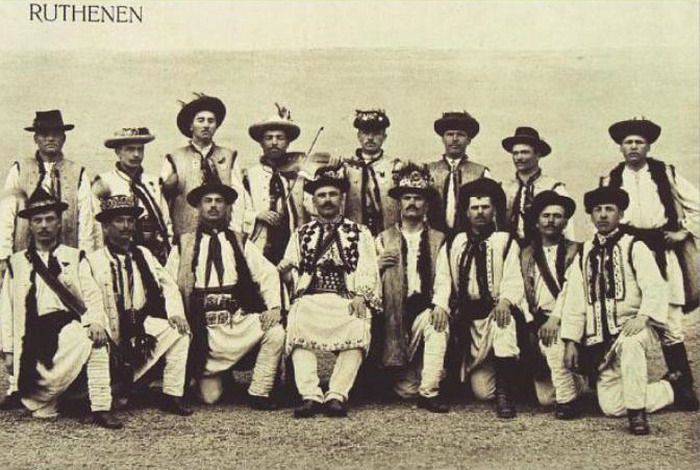
The Rusins lived in Bukovina, who considered themselves to be the “Russian” people (exactly, from the word “Rus”). As the well-known Bukovinian public activist Alexei Gerovsky (1883-1972) wrote in his time, “the Russian population of Bukovina has always considered itself Russian and had no idea that there was any Ukrainian nation and that they should turn into“ Ukrainians ”and no longer call themselves or their language Russian. When, at the end of the last century, the alien Galicians began to propagate the idea of separatism in Bukovina, they initially, for several decades, did not dare to call themselves or their new "literary" language Ukrainian, but they called themselves and their language Russian (after one with"). All Russian Bukovina people considered this a Polish intrigue ”(quoted in: Gerovsky A.Yu. Ukrainization of Bukovina).
The fastest growing Ukrainization of Bukovina began before the First World War, when, in order to eradicate the pro-Russian sentiment, the Austro-Hungarian authorities began to pay enormous attention to the formation of the construct of the Ukrainian nation. But even after the First World War, most of the Slavic population of Bukovina still identified themselves as Rusyns. The situation changed after the accession of Northern Bukovina to the Soviet Union. In the USSR, there was a Ukrainian Soviet Socialist Republic, the title nation of which was considered the Ukrainians. These Ukrainians were to be formed from the Ukrainians of Central Ukraine, the Great Russians, the Ukrainians and the Russified Greeks of Novorossia, and later from the Galician, Bukovynian and Transcarpathian Rusyns. According to the official census of the population of Ukraine, held in 2001, in Chernivtsi region, existing in the territory of the historical Northern Bukovina, Ukrainians make up 75% of the population, Romanians - 12,5% of the population, Moldovans - 7,3% of the population, Russians - 4,1% of the population, Poles - 0,4 % of the population, Belarusians - 0,2% of the population, Jews - 0,2% of the population.
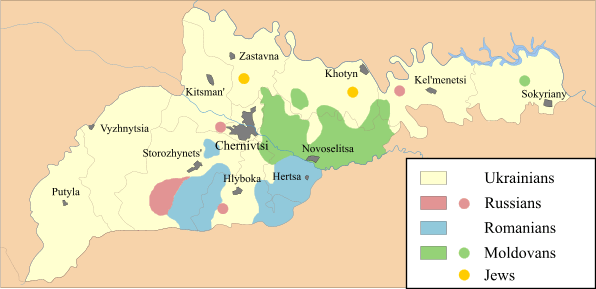 The percentage of ethnic groups in the region is thus fundamentally different from the national map of a hundred years ago. Most clearly the situation is with the majority of the Jewish population of Bukovina, whose share has decreased from 12% to 0,2%. Many Jews could not survive the terrible years of the Nazi occupation, a very large number of Jews, starting from the end of the 19th century, emigrated to other European countries, to the USA, and from the middle of the 20th century to Israel. Some due to inter-ethnic marriages dissolved in the Slavic and Romanian populations. The fate of the Poles is similar to the Jews - those who emigrated left for their historic homeland in Poland, who - dissolved among the “75% of Ukrainians”. The number of Romanians and Moldovans also declined, but not so noticeably. But the Ukrainian population now makes up three-quarters of the residents of Chernivtsi region. But are Bukovina Ukrainians united - that is the question?
The percentage of ethnic groups in the region is thus fundamentally different from the national map of a hundred years ago. Most clearly the situation is with the majority of the Jewish population of Bukovina, whose share has decreased from 12% to 0,2%. Many Jews could not survive the terrible years of the Nazi occupation, a very large number of Jews, starting from the end of the 19th century, emigrated to other European countries, to the USA, and from the middle of the 20th century to Israel. Some due to inter-ethnic marriages dissolved in the Slavic and Romanian populations. The fate of the Poles is similar to the Jews - those who emigrated left for their historic homeland in Poland, who - dissolved among the “75% of Ukrainians”. The number of Romanians and Moldovans also declined, but not so noticeably. But the Ukrainian population now makes up three-quarters of the residents of Chernivtsi region. But are Bukovina Ukrainians united - that is the question?Today, the “Ukrainians” of the Chernivtsi region include both the Ruthenian population and migrants from other regions of the Ukrainian SSR and post-Soviet Ukraine, as well as Russians, Moldovans, Romanians, Jews, Gypsies, Germans, who are enrolled by Ukrainians. Actually, the Ruthenian population of Bukovina was also never united. It consists of three groups. The northeastern regions of the Chernivtsi region are inhabited by Rusnaks, or Bessarabian Rusyns. In the north-west live Podilians, in the western part of the region - Hutsuls. Each of the listed subethnic groups of Rusyns has its own cultural differences and not all of them identify themselves as Ukrainians. Although it should be noted that the position of the Ruthenian movement in the Chernivtsi region is much less strong than in the Transcarpathian.
The process of Ukrainization of the Ruthenian population of Bukovina was begun at the time by the Austro-Hungarian authorities, who feared the spread of pro-Russian sentiments. Of course, the Germanization of the region was an ideal option for the Austro-Hungarian leadership. The German-speaking population made up the majority in Chernivtsi, and in other towns of Bukovina - after all, there were either Germans here - settlers from Austria and Germany, or Jews speaking Yiddish close to German. The Rusyn population was concentrated in rural areas and was not covered by the German-language school system. Therefore, the Austro-Hungarian authorities gradually realized that it would not be possible to Germanize the Ruthenian population and decided that it would be much more effective to include it in the constructed Ukrainian nation. The situation was complicated by the fact that in Galicia there was a strong Polish influence, a significant part of the population professed Uniatism, and the Greek Catholic clergy were a reliable conductor of the idea of “Ukrainization” of the Ruthenian population.
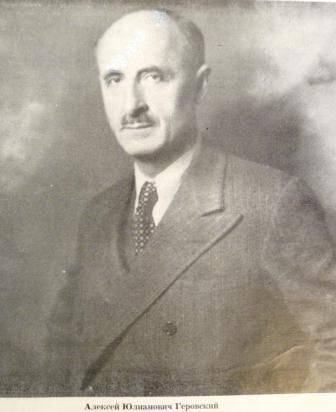 It was more difficult to Ukrainize the Orthodox Slavs of Bukovyna - they did not understand why they had to give up Russian identity if they also professed Orthodoxy and spoke Russian. As A.Yu. recalled. Gerovsky, “in the last decades of the last century, the Bukovinian Russian intelligentsia consisted mainly of Orthodox priests. Uniatov in Bukovina was very small and then only in the cities. But the Uniates at the time considered themselves Russians. In the main city, Chernivtsi, the Uniate Church was called by everyone simply the Russian Church, and the street on which this church was located was even officially called Russish Gasse in German (the official language in Bukovina was German) ”(Gerovsky A.Yu. Ukrainization of Bukovina).
It was more difficult to Ukrainize the Orthodox Slavs of Bukovyna - they did not understand why they had to give up Russian identity if they also professed Orthodoxy and spoke Russian. As A.Yu. recalled. Gerovsky, “in the last decades of the last century, the Bukovinian Russian intelligentsia consisted mainly of Orthodox priests. Uniatov in Bukovina was very small and then only in the cities. But the Uniates at the time considered themselves Russians. In the main city, Chernivtsi, the Uniate Church was called by everyone simply the Russian Church, and the street on which this church was located was even officially called Russish Gasse in German (the official language in Bukovina was German) ”(Gerovsky A.Yu. Ukrainization of Bukovina). To facilitate the task of Ukrainization of Bukovina Rusyns, the Austro-Hungarian authorities appointed teachers and administrators from Galicia to Bukovina who were supposed to convince Bukovina Rusyns of their “Ukrainians” by example. But the local population of such preachers of Ukrainian identity was hostile, and it was not only the lack of understanding of the very meaning of imposing "Ukrainians", but also the commonplace rejection of haughty strangers who were not only appointed to posts instead of local residents, but also considered the latter people of the second grade. The Bukovyn Rusyns hostility towards the preachers of the “Ukrainians” sent from Galicia led to accusations from the latter that the Bukovynians instead of “uniting with the Galician brothers” hit individualism and did not want to participate in the revival of the “united Ukrainian nation”.
Two political adventurers of uncertain national origin, who for some reason considered themselves “Ukrainians”, became the ideologists of the Ukrainianization of Bukovina. The first was Stefan Smal-Stotsky, to whom Chernivtsi University awarded a professorship without any scientific training. The merit of Smal-Stotsky was considered to be the stubborn propaganda of the “independence” of the Ruten (Ruthenian) language from the Russian language. Subsequently, Smal-Stotsky came under investigation for embezzling public money. The second is Baron Nicholas von Vassilko. It seems like an Austrian aristocrat, judging by the prefix "background", but with a name and surname that is too uncharacteristic for a German. In fact, Vassilko was the son of a Romanian and an Armenian, and in general did not own any of the Slavic languages and adverbs - neither Russian, nor Galician, nor Ruthenian. However, it was he who was entrusted by Austria-Hungary to represent the Bukovinian Slavs in the Austrian parliament, since von Vassilko was an active supporter of the concept of the existence of a Ukrainian nation independent of the Russian people.
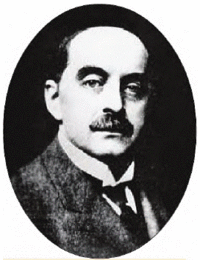 . In modern Ukrainian sources, Vassilko is called "Mykola Mikolovich Vasilko" and, of course, is called a prominent figure in the Ukrainian movement.
. In modern Ukrainian sources, Vassilko is called "Mykola Mikolovich Vasilko" and, of course, is called a prominent figure in the Ukrainian movement. Baron Vasilko not only actively promoted the Ukrainian identity, but also engaged in various economic frauds, playing an important role in the shadow economy of Austria-Hungary. As we can see, financial untidiness often accompanied supporters of Ukrainian nationalism — apparently the Austro-Hungarian authorities chose people who were easy to “hold on a hook” for provocative activities. It was Baron Vassilko who became one of the initiators of mass repressions against the leaders of the Bukovinian pro-Russian movement before the First World War. According to Vasilko’s denunciations, starting from 1910, the Austro-Hungarian authorities carried out the systematic destruction of the Orthodox Ruthenian population in Bukovina. Many prominent figures of the Orthodox pro-Russian movement were killed or were taken to the concentration camp of Talerhof. Thus, this “fiery fighter for the Ukrainian idea” is guilty of the death and maimed destinies of many Slavs of Bukovina. After the Petliura Directorate came to power, Vassilko served as the UNR Ambassador in Switzerland. He died his death in 1924 in Germany.
Evidence of significant cultural differences between Bukovina and Galicia is the indifferent attitude of the residents of Chernivtsi region to the idea of "separatism". During the Great Patriotic War, the Ukrainian nationalists did not manage to enlist the support of the population comparable to Galicia on the territory of Bukovina. In the Great Patriotic War, fighting in the ranks of the Soviet army, 26 thousands of inhabitants died from 100 thousands of Bukovina men and young men called up for military service. It turns out that every fourth Bukovynian man of military age gave his life in the fight against the Nazi occupiers. Up to two thousand residents of Bukovina went into partisan detachments and underground groups. Of course, there were those who joined the ranks of collaborators, Ukrainian nationalist organizations, but in general they were in the minority.
Ukrainization, Romanization or ... with Russia?
After the collapse of the USSR and the declaration of independence of Ukraine, the population of Chernivtsi region met this news less enthusiastic than the residents of Galicia and the Kiev nationalist-minded intelligentsia. For two decades, the Soviet Union in the Chernivtsi region continued the process of Ukrainization, thanks to which Kiev managed to achieve certain progress in the assertion of Ukrainian identity, especially among the younger generation of Bukovina. At the same time, the mood of the residents of Chernivtsi region is much less nationalistic than in the same Galicia. First, this is due to the presence of a significant proportion of national minorities in the population of the region. For example, the same Romanians do not have any sense to support the ideas of Ukrainian nationalism. Moreover, the Romanian population is well aware of the prospects for further developments in the area in the case of strengthening the position of the Kiev regime - a course will be taken to Ukrainize not only the Ruthenian, but also the Romanian and Moldovan population of Bukovina. In a sense, the position of the Bukovinian Romanians resembles the Hungarians of Transcarpathia, however there are significant differences. In recent years, Hungary is perhaps the only country in Eastern Europe that demonstrates the ability for a more or less independent foreign and domestic policy. In particular, Hungary seeks to strengthen economic relations with Russia, the Hungarian patriotic organizations are very concerned about the situation of their fellow tribesmen in the Transcarpathian region of Ukraine.
As for Romania, it is much more dependent on American foreign policy. In fact, Romania follows a puppet course, like other Eastern European countries. Russia is perceived in Romania as a natural adversary, primarily in the context of the Transnistrian conflict. It is known that the Romanian nationalists have long been counting, sooner or later, to include Moldova in the composition of Romania. Naturally, in this case we will talk about the seizure of Transnistria. It is the active policy of the Russian state that impedes the implementation of expansionist plans for the creation of a “Great Romania”.
Back in 1994, three years after the collapse of the USSR, Romania denounced the Treaty on the regime of the Soviet-Romanian border. Thus, claims to Ukraine regarding Northern Bukovina and Bessarabia became open. Only in 2003, between Ukraine and Romania, a new treaty was signed on the Romanian-Ukrainian border, but it was concluded for a ten-year perspective and expired in 2013, just in Euromaidan year, and secondly, Romania signed it in order to have formal reason to be accepted into NATO. After all, a country with unresolved territorial disputes cannot, according to the accepted rules, be part of NATO. When President Viktor Yanukovich was overthrown in 2014 in Kiev as a result of the rebellion, the Romanian government welcomed the “revolution” and promised its support to the new regime. And this is despite the fact that the real interests of Romania lie in the plane of returning to the country of Northern Bukovina. It is not by chance that several years ago in the Chernivtsi region a massive issue of Romanian passports was made to all willing residents of Northern Bukovina of Romanian and Moldovan origin. In total, about 100 of thousands of Ukrainian citizens - residents of Chernivtsi and Odessa regions of Ukraine, received Romanian passports.
Thus, Bucharest not only took the protection of Romanians and Moldovans from Bukovina and Bessarabia, but also made it clear that the likelihood of a situation in which Romanian citizenship in Northern Bukovina would be in real demand is not excluded. Of course, the Kiev regime will not return Chernivtsi region of Romania, because otherwise the Ukrainian leadership will not have any arguments on the situation with the Crimea and the Donbas. But in case of refusal to return the Northern Bukovina of Romania, Ukraine is doomed to preserve the “smoldering conflict” with its southwestern neighbor. The only thing that can prevent this conflict is a direct ban on the showdown on the part of the American owners of Kiev and Bucharest, which we see at the present time.
As for the interests of the population of the Chernivtsi region, it is unlikely that they are identical with the ideas of the Romanian nationalists in Bucharest or the pro-American regime in Kiev. People of different nationalities who inhabit Northern Bukovina want to live and work in peace. Naturally, it is not included in their plans to die in the distant Donbas or send their fathers, husbands and sons there to perish. In fact, the population of the region, like other regions of Ukraine, has become hostage to Kiev’s policies. Policies implemented in the geopolitical interests of the United States, but not in the real interests of the Ukrainian population. Meanwhile, Russia should be more active in the direction of solving the same Bukovinian problem. It is likely that the correct geopolitical way out of this situation would be to strengthen the Russian position in the Chernivtsi region.
The revival of the national identity of the Rusyns - a people recognized in most Eastern European countries, but ignored and discriminated against in Ukraine, is Russia's most important task in the Carpathian region. From time immemorial among the Ruthenian population, pro-Russian sentiments were strong and only brainwashing, organized by supporters of “Ukrainization,” influenced the fact that the descendants of this unique and interesting people largely lost their memory of their nationality and began to identify themselves as Ukrainians. The development of Russian culture in Bukovina is a necessary, but very difficult to implement, especially in modern conditions, component of the policy to strengthen Russian influence. Nevertheless, Russia can also support the pro-Russian part of the region’s population, as Romania does for Romanians or Hungary for Hungarians in Transcarpathia.
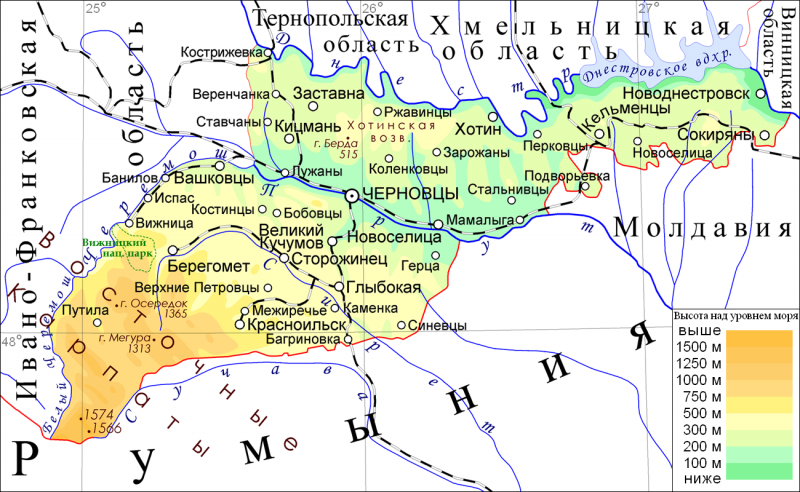
Information